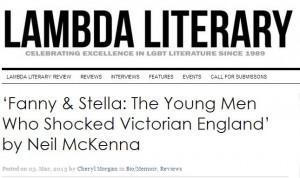The following review was posted on 03. Mar, 2013 by Cheryl Morgan, Lambda Literary in Bio/Memoir, Reviews. It is a very thoughtful, well-written and fair review. Cheryl has obviously picked up every nuance of the book.
 When we think of Victorian England we tend to assume a moral code that was as tightly laced as the corsets into which women forced themselves.
When we think of Victorian England we tend to assume a moral code that was as tightly laced as the corsets into which women forced themselves.
Surely there can have been no room for outrageous campness in such a society. Yet appearances can be deceptive. Human nature has a way of shining through the worst of adversity. Love, and of course lust, will find a way. Neil McKenna’s new biography, Fanny & Stella, helpfully subtitled The Young Men Who Shocked Victorian England, least anyone remain ignorant of the degree of gender bending going on here, tells the story of the two most flamboyant members of Victorian London’s gay scene.
Sodomy was illegal in the London of 1870. This, however, did nothing to dampen the spirits and desires of the city’s men-folk. If gay sex could not be had openly, why then it would have to be purchased in secret.
The back streets of London thronged, not just with jolly cockney whores waiting innocently for mysterious serial killers, but also with young men who, by dint of shyness, mincing, or full drag, advertised their availability for liaisons. These Mary-Anns, as they were known, were often left to their own devices, but they were always vulnerable to arrest, especially if they failed to keep to the back streets where their presumed social betters felt that they belonged.
Fanny and Stella, or Frederick Park and Ernest Boulton, as they were named when they first entered the world, were anything but shy and retiring. They paraded the streets dressed as women, shopping for the latest styles in the fashionable Burlington Arcade. They rented a box at the theatre, got drunk, and made lewd suggestions to men in the stalls below. They even put on theatrical performances of their own, always taking female parts. Young men in the audiences would become greatly aroused by the charms of the beautiful Miss Stella Boulton, and be quite shocked when the reason for her lack of marriagability was explained to them.
Worse still, Fanny and Stella were of good breeding. Fanny’s father was a judge. And their entourage was even better connected. Stella’s legion of admirers included Mr. John Safford Fiske, the US Consul in Edinburgh, and Lord Arthur Clinton, MP, a younger brother of the Duke of Newcastle. Lord Arthur and Stella even lived together as man and wife, leading Stella to have business cards made in the name of Lady Stella Clinton. The more homely Fanny styled herself Mrs. Fanny Graham (widow). It was perhaps their presence in polite society that caused the Attorney-General, Sir Robert Collier, and his dogged assistant, Inspector James Thompson, to decide that Something Must Be Done.
Fanny and Stella were arrested at the Strand Theatre in April 1870. The case of the Young Men In Women’s Clothes soon gripped the attention of the nation, and of course its newspapers. Solid, middle class people were entirely shocked to learn of the depravity going on in their midst. Yet, as McKenna makes clear in his book, our two heroines were unusual only in their boldness. They frequented a certain house in Wakefield Street, Bloomsbury, owned by a Miss Martha Stacey, where young men with particular inclinations could store their collections of women’s clothes, meet to dress and swap fashion tips, and of course go out on the town. One of the other regulars was rumored to be the nephew of Sir Robert Peel.
Inspector Thompson and his men were well aware of this house, and raided it shortly after the arrest, taking away a great quantity of petticoats, jewelry, powders and the like, all of which were paraded before the confused jury and salivating journalists. This was a show trial, with an attendant media circus. And yes, even in those days, bathroom panic was top of everyone’s list of potential moral outrages.
Inevitably there was a great deal of fleeing to the Continent by persons known to be connected to the accused. John Safford Fiske found himself in Newgate prison as a co-defendant. He offered to resign, but was told by his superiors not to do so unless he could find something more dignified than prison notepaper on which to write his letter. Lord Arthur, after the tradition of the British aristocracy, elected to spend the rest of his life presumed dead. While this doubtless cramped his social style, it was clearly not irreversibly fatal as some of his relatives took the precaution of writing him out of their wills after he had “died”.
Meanwhile, friends in high places were providing help in the form of a high powered legal defense team. Under merciless cross-examination it soon became apparent that Fanny and Stella had been the victims of a stitch-up. Ranged against them was a rag-tag alliance of bumbling and corrupt policemen, morally outraged matrons, opportunist informants, and peculiarly obsessed doctors. In the Metropolitan Police, it seemed, bent coppers were in the habit of soliciting sex from young men, and then blackmailing them with threats of arrest. They were also not above bribing people to testify in their support in court. As for the doctors, their eagerness to poke their fingers into the bottoms of pretty boys in search of evidence of sodomy ought surely to have resulted in the creation of a new category of sexual perversion.
American Psychiatric Association where are you?
McKenna tells the whole story, from the shock of arrest, through flashbacks of the glorious careers of our heroines, to the drama of the trial, with remarkable verve and humor. I confess to tearing up when Fanny and Stella were finally pronounced not guilty. It is a thoroughly delightful book. However, as a trans woman myself, I could not help but wonder what these two young women felt about themselves. If full medical gender transition had been available at the time, would they have taken it? Or, as McKenna and all of the reviews I have seen mostly have it, were they simply two outrageously gay boys who liked to drag up to advertise their predilections?
One important piece of evidence is that both Fanny and Stella cross-dressed enthusiastically as children. There was much less gender policing of kids in those days. However, as anyone who has worked with gender-variant children knows, this is by no means a firm indictor of an eventual trans identity. Interestingly Fanny had a brother, Harry, who was gay, but was perfectly comfortable in his male identity and never felt the need to cross-dress.
One of Stella’s more persistent suitors was Louis Hurt. She would doubtless have rejected him simply because he was boring, but McKenna notes his distaste for her feminine side. Louis was in love with Ernest Boulton, not with Stella, and that counted against him.
However, McKenna also notes that Fanny and Stella did not spend their entire lives in drag. He writes:
…they promenaded and paraded the streets of London, sometimes in drag and sometimes out of drag (and sometimes half-in and half-out, which confused and confounded everybody and meant that no one could be quite sure who or what they were).
Thanks to a particularly nosy Irish rent boy named Jack Saul, we have what purports to be a first hand account of Stella and Lord Arthur enjoying each other’s company, as observed through a convenient keyhole. If Saul is to be believed, Stella was in no way reticent about her anatomy, and indeed relished the use of it. On that evidence, a modern gender psychiatrist would have no hesitation in deeming her unsuitable for transition.
Yet what can we really know? Given that the whole concept of medical gender transition was unknown in Victorian times, how can we tell how Fanny and Stella would have viewed the prospect? We get ourselves into enough trouble trying to reconcile Western ideas of gender with those held by gender-variant people from other cultures, without trying to look into our own past as well.
It is impossible to say, therefore, what gender identities Fanny and Stella would have claimed for themselves. Within the wider trans umbrella, however, they most certainly have a place. As McKenna’s book makes plain, they were defiantly and outrageously genderqueer, and we should celebrate them for that.






